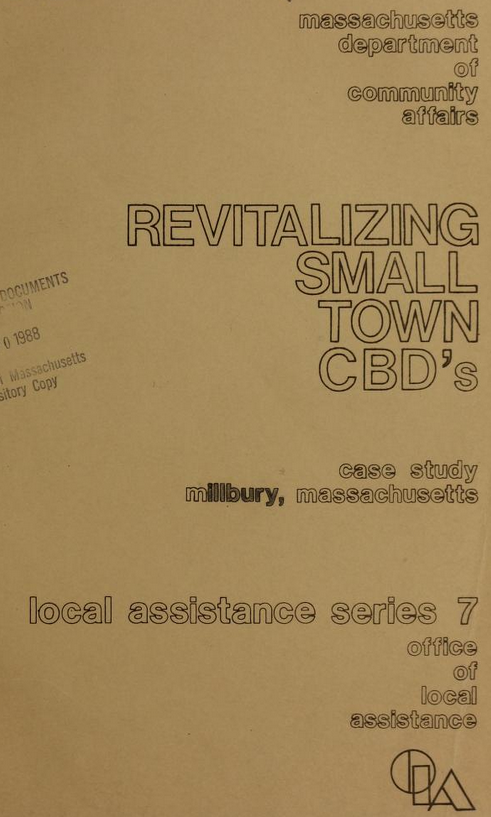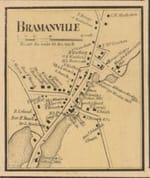While it's been quiet at the Tribune, it's not due to a lack of activity. More coming in the next few weeks...
I spent my Monday afternoon at the Asa Waters Mansion for the library's Summer Reading kickoff. My usual route into the center of town was diverted, however, by a significant amount of construction in the center of town. Basically, from the Coop to the Center, no cars getting in or out, meaning Grove and Church Streets were getting a lot of additional traffic.
Outside of my personal propensity for scheduling large library events around the same time as municipal construction projects, however, it gave me a little time to sit with my laptop and do some research. As is the tendency, one thing led to another and my research on Western Massachusetts towns stumbled into a new (to me) resource for Millbury history via the Internet Archive's OpenLibrary.
The OpenLibrary, for those not in the know, is a great archive of ebooks in readable and downloadable formats. Many of the scans of old historic books by Google about 15 years back are archived here, along with some other books that maybe shouldn't have been, but there are a few titles of interest to Millbury buffs. For me, though, the publication that derailed me was Revitalizing small town central business districts: with case study for town of Millbury, Massachusetts.

The publication is very specialized, and not really intended for public consumption in 1975, never mind 2023. With that said, this does provide a lot of insight into what has and hasn't changed in terms of "best practices" for planning in so-called "central business districts" or "CBDs." For example, this insight regarding commercial activity:
Millbury is one of 5 places... without a specialty. All five are below the... average in sales per capita, but Millbury has distinctly the highest ranking among them. It is well balanced between the "daily needs" categories (food, gas, eating places; drugstores not disclosed) and other retail, with 38-42% of its sales in "daily needs"... This is not to say that Millbury could not support more retail of all kinds, but the variety of offerings present does help to explain why its sales have held up despite the absence of an ace drawing card.
The degree of concentration becomes more vivid in Table 5. For instance, 61% of the apparel sold outside Worcester went through Auburn or Shrewsbury. Over 407, of all automobiles sold outside the city were sold in just two places, Westborough and Holden. Two places, Auburn and Shrewsbury, were hosts to 25% of the dining public outside the city. Auburn alone accounted for 19% of miscellaneous retail sales through non-Worcester outlets.
If one may dare to generalize from these limited examples, it is to say that while shopping malls and other businesses along major highways attract the most dollars away from the city, the range of small-scale retail and services a sound small CBD can provide has continued to support the CBD's place in the overall economic hierarchy.
Sure, the Auburn Mall is a shell of itself these days, but is this especially surprising even now? Millbury gets a lot of the consumers up to the Shoppes from outside of the town, the same type of retail foot traffic that used to head over to Auburn back then.
The publication, however, is noteworthy to us because they use Millbury as a case study. For example, they describe Millbury's residential sprawl as follows:
The great mobility conferred by the automobile together with the tremendous increase in automobile ownership in recent decades freed residential locations to a certain extent from the need to be physically near places of work or business. In the Millbury area, construction of expressways and highways such as Rtes. 146, 122A, 20 and 1-90 extended the range of physical distance within which houses could be located with respect to jobs, shopping, and entertainment facilities. By greatly reducing the time required to go to larger regional shopping centers, such as the Worcester CBD and the Auburn Mall, the automobile sharply reduced the reliance of homeowners on local central business districts for most of their daily needs in shopping, entertainment, and business and personal services. The need to conserve fuel arising out of increased cost of gasoline and the increasing costs of essential services have created the need for a more compact pattern and higher densities of residential development.
Local land use policies and zoning can correct this situation somewhat, if not reverse the trend completely, by allowing a more compact development to take place within the service areas of the Central Business Districts. This will mean permitting higher density residential building types such a3 garden apartments and townhouses within a distance of a ten- to- twenty-minute walk or a short car ride from the CBD. Accordingly, we shall recommend certain zoning changes and suggest areas suitable for higher density residential development.
It's funny to consider automobiles as unique enough to highlight, but it's interesting about how little has changed. 146, I-90 still matter. Gas is still expensive. Zoning is still a challenge.
Later, they start going into the aesthetics. Tell me this doesn't sound familiar:
In Millbury Center, there is a general lack of aesthetic appeal, due to an absence of planters, trees (except on the common) and other landscape features. The junction area generally and the parking lot on the southeast corner present an untidy appearance.
South Main Street is in poor condition with dilapidated or illmaintained structures, broken or non-existent sidewalks and messy surroundings. On East Elm Street, buildings on the south side are old and dilapidated and in a poor state of repair.
You probably could have written that in 2015, never mind 1975.
The whole case study is worth reading as a snapshot of the outside perspective of the town. It recognizes the historic value of so much of the area, but also the potential for more. It identifies places that should be celebrated and maintained alongside locations that could host the necessary community improvements. It's worth reading.
My interest in this topic, however, is because I've become a believer in how critical central business districts are to communities and how much just a little bit makes a big difference. I grew up here; growing up we might have hit Ray's Hardware/True Value or the Village Knoll on occasion, but my memories of shopping trips were more about the Auburn Mall, the Big Y, stuff like that. Once I hit high school and college, going out on my own to do my own things, I would hang out in Worcester or go to different stores in the suburbs because I not only grew up assuming Millbury didn't have it, but knew Millbury still didn't have it.
In 2023, Millbury still probably doesn't have it (unless "it" is up on the hill), but we're getting better. It was Cake Shop or bust if you wanted a coffee prior to the last couple years, and good luck to you if you wanted to go to a non-divey bar with friends on a Saturday night. Of what we had? None of it was in the center of town, and likely not within walking distance of anything else. Today, though? You can have an entire night on the town on foot without any issues. Grab some food at the Coop or Calabria, hit a movie at the Elm or a summer concert on the common, grab a nightcap at Spicy Water or Penny Pinchers.
We couldn't do this even five years ago. That's how much things changed, and it's only getting better. Thus my frustration with locals who have nothing but complaints about the town center revitalization. A multi-million dollar project funded largely by out-of-town taxpayers that make the downtown more walkable and objectively better looking means that more of these centralized businesses will be able to operate and provide those sorts of evenings that simply weren't available to us locally.
I don't think anyone has fully considered how unfriendly Millbury looked prior to this revitalization. The empty storefronts, the outdated... everything. I know we have short memories and COVID created a strange pre- and post- gap, but things are so much better now. Yeah, maybe a smoke shop isn't the thing any of us envisioned for a modern, walkable center, but do we really prefer the remnants of Reliant in an otherwise empty lot? Do you want just another parking lot, or maybe a little bit of shade where you could at least have the opportunity to eat lunch?
Listen, modern planning isn't perfect, and we know it's expensive. But the basic principles aren't new, even if the execution of them has changed - it might not be based around "central business districts" anymore, but that's okay. Today, we want walkable, yes, but we want livable, too. We want places to go, things to do, and there's no better spot than the center of town to do it.
And if there's some gorgeous plants and stonework features to pretty it up along the way? All the better.
Jeff Raymond is a Founding Editor of the Bramanville Tribune. He can be reached at jeff.raymond@bramanvilletribune.com. Follow him on Twitter at @jeffinmillbury


Member discussion: